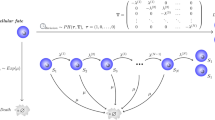Abstract
The division tracking dye, carboxyfluorescin diacetate succinimidyl ester (CFSE) is currently the most informative labeling technique for characterizing the division history of cells in the immune system. Gett and Hodgkin [Nat. Immunol. 1:239–244, 2000] have pioneered the quantitative analysis of CFSE data. We confirm and extend their data analysis approach using simple mathematical models. We employ the extended Gett and Hodgkin [Nat. Immunol. 1:239–244, 2000] method to estimate the time to first division, the fraction of cells recruited into division, the cell cycle time, and the average death rate from CFSE data on T cells stimulated under different concentrations of IL-2. The same data is also fitted with a simple mathematical model that we derived by reformulating the numerical model of Deenick et al. [J. Immunol. 170:4963–4972, 2003]. By a non-linear fitting procedure we estimate parameter values and confidence intervals to identify the parameters that are influenced by the IL-2 concentration. We obtain a significantly better fit to the data when we assume that the T cell death rate depends on the number of divisions cells have completed. We provide an outlook on future work that involves extending the Deenick et al. [J. Immunol. 170:4963–4972, 2003] model into the classical smith-martin model, and into a model with arbitrary probability distributions for death and division through subsequent divisions.
Similar content being viewed by others
Abbreviations
- “anti-CD3 mAb”:
-
monoclonal antibody (mAb) triggering T cell activation via the CD3 molecule associated with T cell antigen receptors
- interleukin-2 (IL-2):
-
growth factor for T cells that is measured in “units/ml”, where 1 unit/ml is the concentration required to give 50% of the maximum response in the HT2 bioassay (Mosmann et al., 1986)
- “thymidine”:
-
radioactively labeled 3H-thymidine that is incorporated in the DNA of dividing cells
- BrdU:
-
nucleotide analog 5-bromo-2′-deoxyuridine also incorporated in the DNA of dividing cells
- CFSE:
-
color dye “carboxyfluorescin diacetate succinimidyl ester” which is taken up in the cytosol of cells, and which dilutes twofold when cells divides
References
Bernard, S., Pujo-Menjouet, L., Mackey, M.C., 2003. Analysis of cell kinetics using a cell division marker: mathematical modeling of experimental data. Biophys. J. 84(5), 3414–3424.
De Boer, R.J., Perelson, A.S., 2005. Estimating division and death rates from CFSE data. J. Comp. Appl. Math. 184, 140–164.
Deenick, E.K., Gett, A.V., Hodgkin, P.D., 2003. Stochastic model of T cell proliferation: A calculus revealing IL-2 regulation of precursor frequencies, cell cycle time, and survival. J. Immunol. 170, 4963–4972.
Diekmann, O., Gyllenberg, M., Huang, H., Kirkilionis, M., Metz, J.A., Thieme, H.R., 2001. On the formulation and analysis of general deterministic structured population models. II. Nonlinear theory. J. Math. Biol. 43, 157–189.
Efron, B., Tibshirani, R., 1986. Bootstrap methods for standard errors, confidence intervals, and other measures of statistical accuracy. Stat. Sci. 1, 54–77.
Ganusov, V.V., Pilyugin, S.S., De Boer, R.J., Murali-Krishna, K., Ahmed, R., Antia, R., 2005. Quantifying cell turnover using CFSE data. J. Immunol. Methods 298, 183–200.
Gett, A.V., Hodgkin, P.D., 1998. Cell division regulates the T cell cytokine repertoire, revealing a mechanism underlying immune class regulation. Proc. Natl. Acad. Sci. U.S.A. 95, 9488–9493.
Gett, A.V., Hodgkin, P.D., 2000. A cellular calculus for signal integration by T cells. Nat. Immunol. 1, 239–244.
Hasbold, J., Corcoran, L.M., Tarlinton, D.M., Tangye, S.G., Hodgkin, P.D., 2004. Evidence from the generation of immunoglobulin G-secreting cells that stochastic mechanisms regulate lymphocyte differentiation. Nat. Immunol. 5, 55–63.
Hasbold, J., Gett, A.V., Rush, J.S., Deenick, E., Avery, D., Jun, J., Hodgkin, P.D., 1999. Quantitative analysis of lymphocyte differentiation and proliferation in vitro using carboxyfluorescein diacetate succinimidyl ester. Immunol. Cell. Biol. 77, 516–522.
Kaech, S.M., Ahmed, R., 2001. Memory CD8+ T cell differentiation: initial antigen encounter triggers a developmental program in naive cells. Nat. Immunol. 2, 415–422.
Leon, K., Faro, J., Carneiro, J., 2004. A general mathematical framework to model generation structure in a population of asynchronously dividing cells. J. theor. Biol. 229, 455–476.
Lyons, A.B., 2000. Analysing cell division in vivo and in vitro using flow cytometric measurement of CFSE dye dilution. J. Immunol. Methods. 243, 147–154.
Milutinović, D., 2004. Stochastic Model of Micro-Agent Populations. PhD Thesis, Institute for Systems and Robotics, Instituto Superior Tecnico, Lisbon, Portugal.
Mosmann, T.R., Bond, M.W., Coffman, R.L., Ohara, J., Paul, W.E., 1986. T-cell and mast cell lines respond to B-cell stimulatory factor 1. Proc. Natl. Acad. Sci. U.S.A. 83(15), 5654–5658.
Nordon, R.E., Nakamura, M., Ramirez, C., Odell, R., 1999. Analysis of growth kinetics by division tracking. Immunol. Cell. Biol. 77(6), 523–529.
Pilyugin, S.S., Ganusov, V.V., Murali-Krishna, K., Ahmed, R., Antia, R., 2003. The rescaling method for quantifying the turnover of cell populations. J. Theor. Biol. 225, 275–283.
Revy, P., Sospedra, M., Barbour, B., Trautmann, A., 2001. Functional antigen-independent synapses formed between T cells and dendritic cells. Nat. Immunol. 2, 925–931.
Smith, J.A., Martin, L., 1973. Do cells cycle? Proc. Natl. Acad. Sci. U.S.A. 70, 1263–1267.
Van Stipdonk, M.J., Lemmens, E.E., Schoenberger, S.P., 2001. Naive CTLs require a single brief period of antigenic stimulation for clonal expansion and differentiation. Nat. Immunol. 2, 423–429.
Veiga-Fernandes, H., Walter, U., Bourgeois, C., McLean, A., Rocha, B., 2000. Response of naive and memory CD8+ T cells to antigen stimulation in vivo. Nat. Immunol. 1, 47–53.
Zhang, X.W., Audet, J., Piret, J.M., Li, Y.X., 2001. Cell cycle distribution of primitive haematopoietic cells stimulated in vitro and in vivo. Cell. Prolif. 34(5), 321–330.
Author information
Authors and Affiliations
Corresponding author
Rights and permissions
About this article
Cite this article
De Boer, R.J., Ganusov, V.V., Milutinović, D. et al. Estimating Lymphocyte Division and Death Rates from CFSE Data. Bull. Math. Biol. 68, 1011–1031 (2006). https://doi.org/10.1007/s11538-006-9094-8
Received:
Accepted:
Published:
Issue Date:
DOI: https://doi.org/10.1007/s11538-006-9094-8




